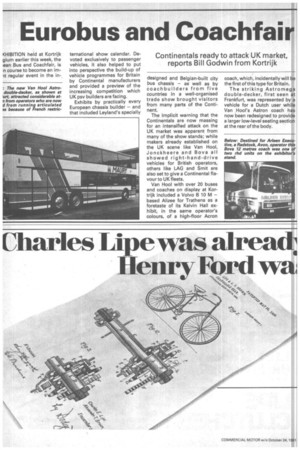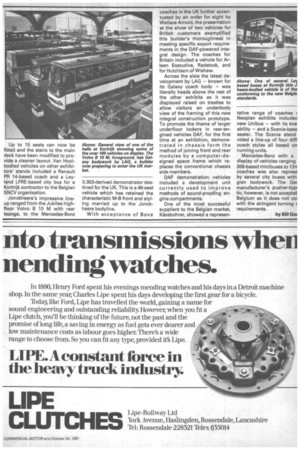Eurobus and Coachfair
Page 42

Page 43

If you've noticed an error in this article please click here to report it so we can fix it.
Continentals ready to attack UK market, reports Bill Godwin from Kortrijk
KHIBITION held at Kortrijk gium earlier this week, the ,ean Bus and Coachfair, is n course to become an im-it regular event in the in
ternational show calendar. Devoted exclusively to passenger vehicles, it also helped to put into perspective the build-up of vehicle programmes for Britain by Continental manufacturers and provided a preview of the increasing competition which UK psv builders are facing.
Exhibits by practically every European chassis builder — and that included Leyland's specially designed and Belgian-built city bus chassis — as well as by coachbuilders from five countries in a well-organised trade show brought visitors from many parts of the Continent.
The implicit warning that the Continentals are now massing for an intensified attack on the UK market was apparent from many of the show stands; while makers already established on the UK scene like Van Hool, Jonckheere and Bova all showed right-hand-drive vehicles for British operators, others like LAG and Smit are also set to give a Continental flavour to UK fleets.
Van Hool with over 20 buses and coaches on display at Kortrijk included a Volvo B 10 M — based Alizee for Trathens as a foretaste of its Kelvin Hall exhibit, in the same operator's colours, of a high-floor Acron coach, which, incidentally will be the first of this type for Britain.
The striking Astromega double-decker, first seen at Frankfurt, was represented by a vehicle for a Dutch user while Van Hool's Astron coach has now been redesigned to provide a larger low-level seating section at the rear of the body.
Up to 15 seats can now be fitted and the stairs to the main deck have been modified to provide a cleaner layout. Van Hoolbodied vehicles on other exhibitors' stands included a Renault PR 14-based coach and a Leyland LFRE-based city bus for a Kortrijk contractor to the Belgian SNCV organisation.
Jonckheere's impressive lineup ranged from the Jubilee highfloor Volvo B 10 M with rear lounge, to the Mercedes-Benz 0.303-derived demonstrator destined for the UK. This is a 48-seat vehicle which has retained the characteristic M-B front and styling married up to the Jonckheere bodyline.
With acceptance of Bova coaches in the UK further accentuated by an order for eight by Wallace Arnold, the presentation at the show of two vehicles for British customers exemplified this builder's thoroughness in meeting specific export requirements in the DAF-powered integral design. The coaches for Britain included a vehicle for Arleen Executive, Radstock, and for Hutchison of Wishaw.
Across the aisle the latest development by LAG — known for its Galaxy coach body — was literally heads above the rest of the other exhibits as it was displayed raised on trestles to allow visitors an underbody view of the framing of this new integral construction prototype. To promote the theme of larger underfloor lockers in rear-engined vehicles DAF, for the first time at an exhibition, demonstrated in chassis form the method of joining front and rear modules by a computer-designed space frame which replaces the conventional chassis side members.
DAF demonstration vehicles included a development unit currently used to improve methods of sound-proofing engine compartments.
One of the most successful suppliers to the Belgian market, Kassbohrer, showed a represen
tative range of coaches Neoplan exhibits included new Unibus — with its kne ability — and a Scania-base seater. The Scania stand vided a line-up of four cliff, coach styles all based on running units.
Mercedes-Benz with a display of vehicles ranging 308-based minibuses to 12rr coaches was also represe by several city buses with gian bodywork. The Ger manufacturer's •pusher-typc tic, however, is not acceptat Belgium as it does not col with the stringent turning t requirements.
by Bill GO4














































